Editor's note: The El Paso Museum of Art provided
source material to Resource Library for the following article or
essay. If you have questions or comments regarding the source material,
please contact the El Paso Museum of Art directly through either this phone
number or web address:
Wrapped in Tradition: The
Chihuly Collection of Native American Trade Blankets
March 9, 2008 - May 18, 2008
Dale Chihuly was inspired
early in his career by the color and design of 19th century, Native American
trade-blankets as the basis for his "Navajo Blanket 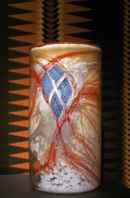 Cylinders." Exhibited together, Chihuly's 15 exquisite
hand-blown glass vessels and 80 historic Navajo blankets are a tribute to
the artistic accomplishments of earlier Native American artists and an artist
who has changed glass from a craft medium to a world-class fine art. This
exhibition is organized by the Dale Chihuly Studio in cooperation with the
Oregon Historical Society. (right: Dale Chihuly, Navajo Blanket
Cylinder, hand-blown glass vessel)
Cylinders." Exhibited together, Chihuly's 15 exquisite
hand-blown glass vessels and 80 historic Navajo blankets are a tribute to
the artistic accomplishments of earlier Native American artists and an artist
who has changed glass from a craft medium to a world-class fine art. This
exhibition is organized by the Dale Chihuly Studio in cooperation with the
Oregon Historical Society. (right: Dale Chihuly, Navajo Blanket
Cylinder, hand-blown glass vessel)
Biography
Dale Chihuly is most frequently lauded for revolutionizing
the Studio Glass movement by expanding its original premise of the solitary
artist working in a studio environment to encompass the notion of collaborative
teams and a division of labor within the creative process. However, Chihuly's
contribution extends well beyond the boundaries both of this movement and
even the field of glass: his achievements have influenced contemporary art
in general. Chihuly's practice of using teams has led to the development
of complex, multipart sculptures of dramatic beauty that place him in the
leadership role of moving blown glass out of the confines of the small,
precious object and into the realm of large-scale contemporary sculpture.
In fact, Chihuly deserves credit for establishing the blown glass form as
an accepted vehicle for installation and environmental art beginning in
the late twentieth century and continuing today.
A prodigiously prolific artist whose work balances content
with an investigation of the material's properties of translucency and transparency,
Chihuly began working with glass at a time when reverence for the medium
and for technique was paramount. A student of interior design and architecture
in the early 1960s, by 1965 he had become captivated by the process of glassblowing.
He enrolled in the University of Wisconsin's hot glass program, the first
of its kind in the United States, established by Studio Glass movement founder
Harvey K. Littleton. After receiving a degree in sculpture, Chihuly was
admitted to the ceramics program at the Rhode Island School of Design, only
to establish its renowned glass program, turning out a generation of recognized
artists.
Influenced by an environment that fostered the blurring
of boundaries separating all the arts, as early as 1967 Chihuly was using
neon, argon, and blown glass forms to create room-sized installations of
organic, freestanding, plantlike imagery. He brought this interdisciplinary
approach to the arts to the legendary Pilchuck School in Stanwood, Washington,
which he co founded in 1971 and served as its first artistic director until
1989. Under Chihuly's guidance, Pilchuck has become a gathering place for
international artists with diverse backgrounds. Over the years his studios,
which include an old racing shell factory in Seattle called The Boathouse
and now buildings in the Ballard section of the city and Tacoma, have become
a mecca for artists, collectors, and museum professionals involved in all
media.
Stylistically over the past forty years, Chihuly's sculptures
in glass have explored color, line, and assemblage. Although his work ranges
from the single vessel to indoor/outdoor site-specific installations, he
is best known for his multipart blown compositions. These works fall into
the categories of mini-environments designed for the tabletop as well as
large, often serialized forms that are innovatively displayed in groupings
on a wide variety of surfaces ranging from pedestals to bodies of natural
water. Masses of these blown forms also have been affixed to specially engineered
structures that dominate large exterior or interior spaces.
Over the years Chihuly and his teams have created a wide
vocabulary of blown forms, revisiting and refining earlier shapes while
at the same time creating exciting new elements, such as his Fiori, all
of which demonstrate mastery and understanding of glassblowing techniques.
Earlier forms, such as the Baskets, Seaforms, Ikebana, Venetians, and Chandeliers,
from the late 1970s through the 1990s have been augmented since the early
to mid-1990s with new blown elements. Chihuly and his teams primarily developed
these while working in glass factories in France, Finland, Ireland, and
Mexico. The resulting Reeds, Saguaros, Herons, Belugas, Seal Pups, and other
forms are now juxtaposed with the earlier series, including Macchia, Niijima
Floats, and Persians in lively new contexts.
Since the early 1980s, all of Chihuly's work has been marked
by intense, vibrant color and by subtle linear decoration. At first he achieved
patterns by fusing into the surface of his vessels "drawings"
composed of prearranged glass threads; he then had his forms blown in optic
molds, which created ribbed motifs. He also explored in the Macchia series
bold, colorful lip wraps that contrasted sharply with the brilliant colors
of his vessels. Finally, beginning with the Venetians of the early 1990s,
elongated, linear blown forms, a product of the glassblowing process, have
become part of his vocabulary, resulting in highly baroque, writhing elements.
In recent years Chihuly has experimented with Polyvitro to create new interpretations
of some of his glass forms.
Chihuly's work is strongly autobiographical. His fascination
with abstracted flower forms, for him, reminiscent of his mother's garden
in Tacoma, has been discussed in depth in the literature. Likewise, series
such as his Seaforms, Niijima Floats, the Chandeliers, and more recently,
the Boats allude to his childhood in Tacoma, Washington, marked by his love
of the sea and his recognition of its importance to the economy of the Pacific
Northwest. Even in the few instances in which the artist has chosen to respond
to earlier historical decorative arts forms, the imagery has personal significance.
The Basket series, for instance, developed out of the woven Northwest Coast
Indian baskets that Chihuly saw in 1977 with his late friend the sculptor
Italo Scanga and sculptor James Carpenter at the Tacoma Historical Society.
Over the years the artist has created a number of memorable
installation exhibitions, including Chihuly Over Venice (1995-96),
Chihuly in the Light of Jerusalem 2000 at the Tower of David Museum
of the History of Jerusalem (2000), Chihuly in the Park: A Garden of
Glass at Chicago's Garfield Park Conservatory (2001-2), the Chihuly
Bridge of Glass in Tacoma (2002), and Mille Fiori at the Tacoma
Art Museum (2003). These installations confirm the artist's sensitivity
to architectural context and his interest in the interplay of natural light
on the glass that exploits its translucency and transparency. Recent situations
have heightened this effect, since the sites that he has selected within
existing buildings have been dominated by large walls of glass.
While elements of the earlier installations allude to natural
phenomena such as icicles and vegetation, gardens provide the dominant theme
in Chihuly's most recent ones. Sites that include Chicago's Garfield Park
Conservatory (2001), the Franklin Park Conservatory in Columbus, Ohio (2003),
the Atlanta Botancial Gardens (2004), the Royal Botanic Gardens Kew(2005),
Fairchild Tropical Botanical Garden, Coral Gables, Florida (2006), the Missouri
Botanical Garden, St. Louis (2006), and now, the New York Botanical Garden
(2006) enable the artist to juxtapose monumental, organically shaped sculptural
forms with beautiful landscaping, establishing a direct and immediate interaction
between nature, art, and environmental light.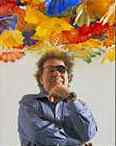
Moreover, Chihuly's Mille Fiori installations at
the Tacoma Art Museum (2003), at Marlborough Gallery, New York (2004), and
more recently at Imago Gallery, Palm Desert, California (2006) and R. Duane
Reed Gallery, St. Louis (2006), reveal the artist's progression toward a
logical next direction: installations that are gardens themselves. Starting
as a massing of churning forms and vibrant colors, the tonality of these
installations has changed to embrace a more limited, single color palate,
reminiscent of the early Chandeliers. In many ways, Chihuly has come full
circle; now using his mature vocabulary, he captures in these installations
the joie de vivre of the plantlike forms of his early neon environments.
A dominant presence in the art world, Dale Chihuly and
his work have long provoked considerable controversy as part of the art/craft
debate. However, with projects such as his recent garden installations in
Kew and New York, there can be little doubt that his lasting contribution
to art of our times is an established fact. (left: Dale Chihuly)
About the Oregon Historical Society
The Oregon Historical Society is located in Portland, Oregon.
OHS publishes journal of record for Oregon history, the Oregon 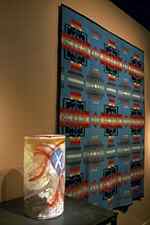 Historical Quarterly. It has
been published continuously since 1900. Over 150 books on Oregon history,
politics and culture, as well as biographies, field guides and exhibit catalogs,
have been published by OHS since the OHS Press was established in 1929.
The OHS artifacts collection is comprised of over 85,000 artifacts, including
ancient objects from the earliest settlements and objects that illustrate
exploration in the Oregon Country, the growth of business and industry,
the development of artwork and crafts, maritime history, and many other
topics. The OHS Research Library contains one of the country's most extensive
collections of state history materials, including approximately 25,000 maps,
30,000 books, 8.5 million feet of film and videotape, 16,000 rolls of microfilm,
and 12,000 linear feet of documents. The Research Library's photographic
archives include over 2.5 million images from pre-statehood to the present
day. OHS Education Programs include internet resources to supplement classroom
curriculum, Folklife cultural programs that focus on the diversity and beauty
of arts and traditions, and teacher training and workshops on Oregon history.
(source: OHS web site; right: photo of Navajo Blanket Cylinder with Native
American Trade Blanket)
Historical Quarterly. It has
been published continuously since 1900. Over 150 books on Oregon history,
politics and culture, as well as biographies, field guides and exhibit catalogs,
have been published by OHS since the OHS Press was established in 1929.
The OHS artifacts collection is comprised of over 85,000 artifacts, including
ancient objects from the earliest settlements and objects that illustrate
exploration in the Oregon Country, the growth of business and industry,
the development of artwork and crafts, maritime history, and many other
topics. The OHS Research Library contains one of the country's most extensive
collections of state history materials, including approximately 25,000 maps,
30,000 books, 8.5 million feet of film and videotape, 16,000 rolls of microfilm,
and 12,000 linear feet of documents. The Research Library's photographic
archives include over 2.5 million images from pre-statehood to the present
day. OHS Education Programs include internet resources to supplement classroom
curriculum, Folklife cultural programs that focus on the diversity and beauty
of arts and traditions, and teacher training and workshops on Oregon history.
(source: OHS web site; right: photo of Navajo Blanket Cylinder with Native
American Trade Blanket)
Editor's note: RL readers may also enjoy:
YouTube illustrated audio presentation: Chihuly
Exhibit - No Transitions [5:48] Chihuly Exhibit at the NY Botanical
Gardens (Bronx, NY) on October 9, 2006
 Dale
Chihuly visits Google's Mountain View, CA headquarters to discuss his
Gardens of Glass. This event took place on June 19, 2008, as part of the
Authors@Google series. [1:02:48]
Dale
Chihuly visits Google's Mountain View, CA headquarters to discuss his
Gardens of Glass. This event took place on June 19, 2008, as part of the
Authors@Google series. [1:02:48]
 Dale
Chihuly [8:32] Glass blower Dale Chihuly talks about his work and his
significant impact on the Studio Glass movement.
Dale
Chihuly [8:32] Glass blower Dale Chihuly talks about his work and his
significant impact on the Studio Glass movement.
TFAO also suggests these DVD or VHS videos:
Chihuly. World renowned glass
artist Dale Chihuly is the subject of six separate documentary programs
included in this 177 minute collection. Each program presents the artist
at work on a different project or exploring his craft with his team of collaborators.
Included: Chihuly Niijima Floats, Chihuly in Action, Chihuly
River of Glass, Chihuly Working with Lino Tagliapietra, Chihuly
Atlantis and Chihuly Working with Pino Signoretto.
Chihuly and the Masters of Venice
(DVD) Dale Chihuly (actor), Pino Signoretto (actor) and Peter West (director)
Tower 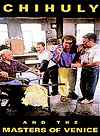 Video Title Note: "Dubbed
"the Picasso of 20th-century glass," American sculptor Dale Chihuly
has earned international acclaim for both his breathtakingly beautiful blown-glass
sculptures and his collaborative approach to art and creativity. This documentary
chronicles Chihuly's historic collaboration with Italian artisans Pino Signoretto
and Lino Tagliapietra, two of the world's greatest living glass masters
and experts in the ancient Venetian traditions of glassblowing." Studio:
Portland Press. DVD Release Date: February 24, 2004
Video Title Note: "Dubbed
"the Picasso of 20th-century glass," American sculptor Dale Chihuly
has earned international acclaim for both his breathtakingly beautiful blown-glass
sculptures and his collaborative approach to art and creativity. This documentary
chronicles Chihuly's historic collaboration with Italian artisans Pino Signoretto
and Lino Tagliapietra, two of the world's greatest living glass masters
and experts in the ancient Venetian traditions of glassblowing." Studio:
Portland Press. DVD Release Date: February 24, 2004
Chihuly at the V&A (DVD)
Dale Chihuly (actor) and Peter West (director). Studio: Portland Press.
DVD Release 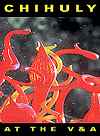 Date: February 24,
2004. Tower Video Title Note: "Dubbed "the Picasso of 20th-century
glass," American sculptor Dale Chihuly has earned international acclaim
for both his breathtakingly beautiful blown-glass sculptures and his collaborative
approach to art and creativity. This documentary chronicles Chihuly's exhibition
at the historic Victoria and Albert Museum in London, which began with a
simple commission for one of the artist's trademark chandeliers and developed
into a fullblown career retrospective of his work."
Date: February 24,
2004. Tower Video Title Note: "Dubbed "the Picasso of 20th-century
glass," American sculptor Dale Chihuly has earned international acclaim
for both his breathtakingly beautiful blown-glass sculptures and his collaborative
approach to art and creativity. This documentary chronicles Chihuly's exhibition
at the historic Victoria and Albert Museum in London, which began with a
simple commission for one of the artist's trademark chandeliers and developed
into a fullblown career retrospective of his work."
Chihuly DVD Collection is a
4-disc boxed set released in 2004, produced by the Museum of Glass. Each
DVD is 60 minutes with an additional 30 minutes of special features. The
videos explore the relationship of nature and glass as Chihuly and his team
work in a variety of outdoor locations, and then install glass among the
lush flora at Chicago's Garfield Park Conservatory. A comprehensive collection,
the Chihuly DVD Collection is a globe-trotting adventure that leads to greater
understanding of the man and his art. ASIN: B0000D1FJH.
 Chihuly In Charlotte is a 2000 video directed by Stuart Grasberg and produced by WTVI,
Charlotte Public Television..
Chihuly In Charlotte is a 2000 video directed by Stuart Grasberg and produced by WTVI,
Charlotte Public Television..
Chihuly in the Light of Jerusalem 2000
(DVD) Dale Chihuly (actor) and Peter West (director) Studio: Portland Press.
DVD Release Date: 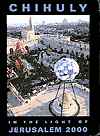 February 22,
2004 . Tower Video Title Note: "Dubbed "the Picasso of 20th-century
glass," American sculptor Dale Chihuly has earned international acclaim
for both his breathtakingly beautiful blown-glass sculptures and his collaborative
approach to art and creativity. This documentary chronicles Chihuly's installation
of 14 glass sculptures in Jerusalem's ancient citadel for the 2000 millennium
celebration."
February 22,
2004 . Tower Video Title Note: "Dubbed "the Picasso of 20th-century
glass," American sculptor Dale Chihuly has earned international acclaim
for both his breathtakingly beautiful blown-glass sculptures and his collaborative
approach to art and creativity. This documentary chronicles Chihuly's installation
of 14 glass sculptures in Jerusalem's ancient citadel for the 2000 millennium
celebration."
Chihuly Over Venice is a 1998
PBS Home Video released by Home Vision Entertainment. The planning and realization
of an ambitious project by renowned  glass
artist Dale Chihuly is documented in this absorbing PBS presentation. Chihuly
collaborated with master glassblowers from four countries to achieve his
collection of spectacular chandeliers for public display over the canals
of Venice. From Finland to Ireland to Mexico to Italy, Chlhuly and the participatlng
artisans join together for a creative 90 minute odyssey. An editorial review
by Rob Lightner for Amazon.com says: "Dale Chihuly's gloriously organic
glass sculptures grace galleries and public spaces around the world, and
Chihuly over Venice follows the artist as he visits glassblowing studios
across Europe and collaborates to create chandeliers for the first international
Biennale of Glass in Venice. Behind-the-scenes glimpses of the hot, dirty
work are cut in with shots of the canals and architecture of Venice to create
a montage of a great artist working in a city with a long tradition of artistic
excellence. We also get candid interviews with Chihuly and his assistants,
which fill in the knowledge and history of the man himself, his work, and
the community of glass artists in the Seattle area. Chihuly over Venice
is a great package for anyone intrigued by the artistic process or enchanted
by the sensuous curves of glass."
glass
artist Dale Chihuly is documented in this absorbing PBS presentation. Chihuly
collaborated with master glassblowers from four countries to achieve his
collection of spectacular chandeliers for public display over the canals
of Venice. From Finland to Ireland to Mexico to Italy, Chlhuly and the participatlng
artisans join together for a creative 90 minute odyssey. An editorial review
by Rob Lightner for Amazon.com says: "Dale Chihuly's gloriously organic
glass sculptures grace galleries and public spaces around the world, and
Chihuly over Venice follows the artist as he visits glassblowing studios
across Europe and collaborates to create chandeliers for the first international
Biennale of Glass in Venice. Behind-the-scenes glimpses of the hot, dirty
work are cut in with shots of the canals and architecture of Venice to create
a montage of a great artist working in a city with a long tradition of artistic
excellence. We also get candid interviews with Chihuly and his assistants,
which fill in the knowledge and history of the man himself, his work, and
the community of glass artists in the Seattle area. Chihuly over Venice
is a great package for anyone intrigued by the artistic process or enchanted
by the sensuous curves of glass."
Chihuly River of Glass (DVD)
Title Note from Tower Video: "Dubbed "the Picasso of 20th-century
glass," American 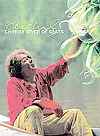 sculptor Dale
Chihuly has earned international acclaim for both his breathtakingly beautiful
blown-glass sculptures and his collaborative approach to art and creativity.
This award-winning documentary follows Chihuly to glassblowing centers in
America, Finland, Ireland, Mexico, and Italy, as he and his team of artisans
create delicately crafted chandeliers to be released into the canals of
Venice for a unique environmental art installation." Studio: Portland
Press. DVD Release Date: February 24, 2004
sculptor Dale
Chihuly has earned international acclaim for both his breathtakingly beautiful
blown-glass sculptures and his collaborative approach to art and creativity.
This award-winning documentary follows Chihuly to glassblowing centers in
America, Finland, Ireland, Mexico, and Italy, as he and his team of artisans
create delicately crafted chandeliers to be released into the canals of
Venice for a unique environmental art installation." Studio: Portland
Press. DVD Release Date: February 24, 2004
-
TFAO does not maintain a lending library of videos or sell videos.
Click here
for information on how to borrow or purchase copies of VHS videos and DVDs
listed in TFAO's Videos -DVD/VHS, an authoritative guide to videos in VHS and DVD format.
Read more articles and essays concerning this source by visiting
the sub-index page for the El Paso Museum of
Art in Resource Library.
Links to sources of information outside of our web site
are provided only as referrals for your further consideration. Please use
due diligence in judging the quality of information contained in these and
all other web sites. Information from linked sources may be inaccurate or
out of date. TFAO neither recommends or endorses these referenced organizations.
Although TFAO includes links to other web sites, it takes no responsibility
for the content or information contained on those other sites, nor exerts
any editorial or other control over them. For more information on evaluating
web pages see TFAO's General Resources
section in Online Resources for Collectors and Students of Art History.
Individual pages in this catalogue will be amended as TFAO adds content,
corrects errors and reorganizes sections for improved readability. Refreshing
or reloading pages enables readers to view the latest updates.
Search Resource
Library for thousands of articles and essays on American art.
Copyright 2008 Traditional Fine Arts Organization, Inc., an Arizona nonprofit corporation. All rights
reserved.
 Cylinders." Exhibited together, Chihuly's 15 exquisite
hand-blown glass vessels and 80 historic Navajo blankets are a tribute to
the artistic accomplishments of earlier Native American artists and an artist
who has changed glass from a craft medium to a world-class fine art. This
exhibition is organized by the Dale Chihuly Studio in cooperation with the
Oregon Historical Society. (right: Dale Chihuly, Navajo Blanket
Cylinder, hand-blown glass vessel)
Cylinders." Exhibited together, Chihuly's 15 exquisite
hand-blown glass vessels and 80 historic Navajo blankets are a tribute to
the artistic accomplishments of earlier Native American artists and an artist
who has changed glass from a craft medium to a world-class fine art. This
exhibition is organized by the Dale Chihuly Studio in cooperation with the
Oregon Historical Society. (right: Dale Chihuly, Navajo Blanket
Cylinder, hand-blown glass vessel)
 Historical Quarterly. It has
been published continuously since 1900. Over 150 books on Oregon history,
politics and culture, as well as biographies, field guides and exhibit catalogs,
have been published by OHS since the OHS Press was established in 1929.
The OHS artifacts collection is comprised of over 85,000 artifacts, including
ancient objects from the earliest settlements and objects that illustrate
exploration in the Oregon Country, the growth of business and industry,
the development of artwork and crafts, maritime history, and many other
topics. The OHS Research Library contains one of the country's most extensive
collections of state history materials, including approximately 25,000 maps,
30,000 books, 8.5 million feet of film and videotape, 16,000 rolls of microfilm,
and 12,000 linear feet of documents. The Research Library's photographic
archives include over 2.5 million images from pre-statehood to the present
day. OHS Education Programs include internet resources to supplement classroom
curriculum, Folklife cultural programs that focus on the diversity and beauty
of arts and traditions, and teacher training and workshops on Oregon history.
(source: OHS web site; right: photo of Navajo Blanket Cylinder with Native
American Trade Blanket)
Historical Quarterly. It has
been published continuously since 1900. Over 150 books on Oregon history,
politics and culture, as well as biographies, field guides and exhibit catalogs,
have been published by OHS since the OHS Press was established in 1929.
The OHS artifacts collection is comprised of over 85,000 artifacts, including
ancient objects from the earliest settlements and objects that illustrate
exploration in the Oregon Country, the growth of business and industry,
the development of artwork and crafts, maritime history, and many other
topics. The OHS Research Library contains one of the country's most extensive
collections of state history materials, including approximately 25,000 maps,
30,000 books, 8.5 million feet of film and videotape, 16,000 rolls of microfilm,
and 12,000 linear feet of documents. The Research Library's photographic
archives include over 2.5 million images from pre-statehood to the present
day. OHS Education Programs include internet resources to supplement classroom
curriculum, Folklife cultural programs that focus on the diversity and beauty
of arts and traditions, and teacher training and workshops on Oregon history.
(source: OHS web site; right: photo of Navajo Blanket Cylinder with Native
American Trade Blanket)
 Video Title Note: "Dubbed
"the Picasso of 20th-century glass," American sculptor Dale Chihuly
has earned international acclaim for both his breathtakingly beautiful blown-glass
sculptures and his collaborative approach to art and creativity. This documentary
chronicles Chihuly's historic collaboration with Italian artisans Pino Signoretto
and Lino Tagliapietra, two of the world's greatest living glass masters
and experts in the ancient Venetian traditions of glassblowing." Studio:
Portland Press. DVD Release Date: February 24, 2004
Video Title Note: "Dubbed
"the Picasso of 20th-century glass," American sculptor Dale Chihuly
has earned international acclaim for both his breathtakingly beautiful blown-glass
sculptures and his collaborative approach to art and creativity. This documentary
chronicles Chihuly's historic collaboration with Italian artisans Pino Signoretto
and Lino Tagliapietra, two of the world's greatest living glass masters
and experts in the ancient Venetian traditions of glassblowing." Studio:
Portland Press. DVD Release Date: February 24, 2004  Date: February 24,
2004. Tower Video Title Note: "Dubbed "the Picasso of 20th-century
glass," American sculptor Dale Chihuly has earned international acclaim
for both his breathtakingly beautiful blown-glass sculptures and his collaborative
approach to art and creativity. This documentary chronicles Chihuly's exhibition
at the historic Victoria and Albert Museum in London, which began with a
simple commission for one of the artist's trademark chandeliers and developed
into a fullblown career retrospective of his work."
Date: February 24,
2004. Tower Video Title Note: "Dubbed "the Picasso of 20th-century
glass," American sculptor Dale Chihuly has earned international acclaim
for both his breathtakingly beautiful blown-glass sculptures and his collaborative
approach to art and creativity. This documentary chronicles Chihuly's exhibition
at the historic Victoria and Albert Museum in London, which began with a
simple commission for one of the artist's trademark chandeliers and developed
into a fullblown career retrospective of his work."  Chihuly In Charlotte is a 2000 video directed by Stuart Grasberg and produced by WTVI,
Charlotte Public Television..
Chihuly In Charlotte is a 2000 video directed by Stuart Grasberg and produced by WTVI,
Charlotte Public Television.. February 22,
2004 . Tower Video Title Note: "Dubbed "the Picasso of 20th-century
glass," American sculptor Dale Chihuly has earned international acclaim
for both his breathtakingly beautiful blown-glass sculptures and his collaborative
approach to art and creativity. This documentary chronicles Chihuly's installation
of 14 glass sculptures in Jerusalem's ancient citadel for the 2000 millennium
celebration."
February 22,
2004 . Tower Video Title Note: "Dubbed "the Picasso of 20th-century
glass," American sculptor Dale Chihuly has earned international acclaim
for both his breathtakingly beautiful blown-glass sculptures and his collaborative
approach to art and creativity. This documentary chronicles Chihuly's installation
of 14 glass sculptures in Jerusalem's ancient citadel for the 2000 millennium
celebration." glass
artist Dale Chihuly is documented in this absorbing PBS presentation. Chihuly
collaborated with master glassblowers from four countries to achieve his
collection of spectacular chandeliers for public display over the canals
of Venice. From Finland to Ireland to Mexico to Italy, Chlhuly and the participatlng
artisans join together for a creative 90 minute odyssey. An editorial review
by Rob Lightner for Amazon.com says: "Dale Chihuly's gloriously organic
glass sculptures grace galleries and public spaces around the world, and
Chihuly over Venice follows the artist as he visits glassblowing studios
across Europe and collaborates to create chandeliers for the first international
Biennale of Glass in Venice. Behind-the-scenes glimpses of the hot, dirty
work are cut in with shots of the canals and architecture of Venice to create
a montage of a great artist working in a city with a long tradition of artistic
excellence. We also get candid interviews with Chihuly and his assistants,
which fill in the knowledge and history of the man himself, his work, and
the community of glass artists in the Seattle area. Chihuly over Venice
is a great package for anyone intrigued by the artistic process or enchanted
by the sensuous curves of glass."
glass
artist Dale Chihuly is documented in this absorbing PBS presentation. Chihuly
collaborated with master glassblowers from four countries to achieve his
collection of spectacular chandeliers for public display over the canals
of Venice. From Finland to Ireland to Mexico to Italy, Chlhuly and the participatlng
artisans join together for a creative 90 minute odyssey. An editorial review
by Rob Lightner for Amazon.com says: "Dale Chihuly's gloriously organic
glass sculptures grace galleries and public spaces around the world, and
Chihuly over Venice follows the artist as he visits glassblowing studios
across Europe and collaborates to create chandeliers for the first international
Biennale of Glass in Venice. Behind-the-scenes glimpses of the hot, dirty
work are cut in with shots of the canals and architecture of Venice to create
a montage of a great artist working in a city with a long tradition of artistic
excellence. We also get candid interviews with Chihuly and his assistants,
which fill in the knowledge and history of the man himself, his work, and
the community of glass artists in the Seattle area. Chihuly over Venice
is a great package for anyone intrigued by the artistic process or enchanted
by the sensuous curves of glass." sculptor Dale
Chihuly has earned international acclaim for both his breathtakingly beautiful
blown-glass sculptures and his collaborative approach to art and creativity.
This award-winning documentary follows Chihuly to glassblowing centers in
America, Finland, Ireland, Mexico, and Italy, as he and his team of artisans
create delicately crafted chandeliers to be released into the canals of
Venice for a unique environmental art installation." Studio: Portland
Press. DVD Release Date: February 24, 2004
sculptor Dale
Chihuly has earned international acclaim for both his breathtakingly beautiful
blown-glass sculptures and his collaborative approach to art and creativity.
This award-winning documentary follows Chihuly to glassblowing centers in
America, Finland, Ireland, Mexico, and Italy, as he and his team of artisans
create delicately crafted chandeliers to be released into the canals of
Venice for a unique environmental art installation." Studio: Portland
Press. DVD Release Date: February 24, 2004